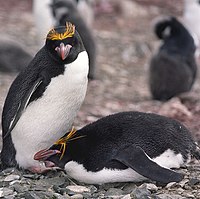Macaroni penguin
Like all penguins, it is flightless, with a streamlined body and wings stiffened and flattened into flippers for a marine lifestyle.
The macaroni penguin was described from the Falkland Islands in 1837 by German naturalist Johann Friedrich von Brandt.
The genus name is derived from the Ancient Greek words eu "good", and dyptes "diver".
The specific name chrysolophus is derived from the Greek words chryse "golden", and lophos "crest".
An adult bird has an average length of around 70 cm (28 in);[3] the weight varies markedly depending on time of year and sex.
The most striking feature is the yellow crest that arises from a patch on the centre of the forehead, and extends horizontally backwards to the nape.
The iris is red and a patch of pinkish bare skin is found from the base of the bill to the eye.
[15] Macaroni penguins range from the Subantarctic to the Antarctic Peninsula; at least 216 breeding colonies at 50 sites have been recorded.
[17] While foraging for food, groups will range north to the islands off Australia, New Zealand, southern Brazil, Tristan da Cunha, and South Africa.
[18] The diet of the macaroni penguin consists of a variety of crustaceans, squid and fish; the proportions that each makes up vary with locality and season.
[19] Cephalopods and small fish such as the marbled rockcod (Notothenia rossii), painted notie (Lepidonotothen larseni), Champsocephalus gunneri, the lanternfish species Krefftichthys anderssoni, Protomyctophum tenisoni and P. normani become more important during chick-rearing.
[19] Macaroni penguins are known to be the largest single consumer of marine resources among all of the seabirds, with an estimated take of 9.2 million tonnes of krill a year.
Scientist Charles Andre Bost found that macaroni penguins nesting at Kerguelen dispersed eastwards over an area exceeding 3×106 km2.
[30] Living in colonies results in a high level of social interaction between birds, which has led to a large repertoire of visual, as well as vocal, displays.
[31] These behaviours peak early in the breeding period, and colonies particularly quieten when the male macaroni penguins are at sea.
[32] Agonistic displays are those which are intended to confront or drive off or, alternatively, appease and avoid conflict with other individuals.
[31] Macaroni penguins, particularly those on adjacent nests, may engage in 'bill-jousting'; birds lock bills and wrestle, each trying to unseat the other, as well as batter with flippers and peck or strike its opponent's nape.
[citation needed] Commencing a few days after females arrive at the colony, sexual displays are used by males to attract partners and advertise their territory, and by pairs once together at the nest site and at changeover of incubation shifts.
[14] Adult macaroni penguins typically begin to breed late in October, and lay their eggs in early November.
[37] Like those of other penguin species, the shell is relatively thick to minimise risk of breakage, and the yolk is large, which is associated with chicks born in an advanced stage of development.
[42] The population of macaroni penguins is estimated at around 18 million mature individuals; a substantial decline has been recorded in several locations.
[43] This includes a 50% reduction in the South Georgia population between the mid-1970s to mid-1990s,[44] and the disappearance of the species from Isla Recalada in Southern Chile.
[46] A 2008 study suggests the abilities of female penguins to reproduce may be negatively affected by climate- and fishing-induced reductions in krill density.






